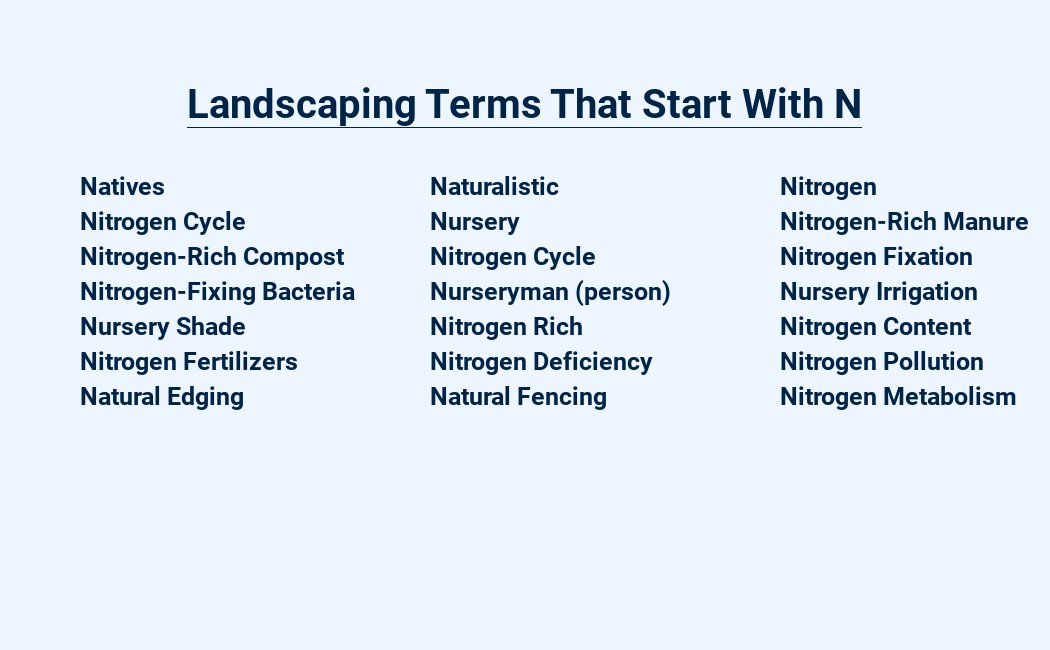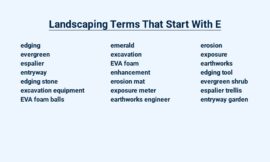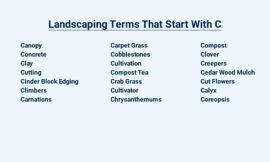Uncover the world of landscaping with me as we embark on a journey through terms beginning with the letter “N.” From the beauty of native plants to the essential role of nitrogen, and the allure of a no-mow lawn, I’ll guide you through the fascinating terms that shape the art of outdoor design.
| Landscaping Terms | Starting with N |
|---|---|
| Native Plant | A plant that naturally occurs in a given region. |
| No-mow Lawn | A lawn that is designed to grow slowly and require less mowing. |
| Nursery | A place where plants are grown and sold. |
Native Plants: Plants that are indigenous to a particular region, climate, or habitat. They are adapted to the specific environmental conditions of their native area and play a crucial role in maintaining ecological balance.
Nitrogen: An essential macronutrient for plant growth, nitrogen is necessary for protein synthesis, chlorophyll production, and overall plant health. It is often added to soils through fertilizers to promote healthy plant growth.
No-mow Lawn: A type of lawn that is managed without regular mowing. It is often planted with a variety of low-growing, drought-tolerant plants that require minimal maintenance. No-mow lawns can help reduce water usage and create a more naturalized and wildlife-friendly landscape.
Nursery: A specialized facility where plants are grown and cultivated for sale. Nurseries provide a controlled environment for plant propagation, growth, and care, ensuring that plants are healthy and ready for transplantation into gardens and landscapes.
Nutrients: Essential elements or compounds required for plant growth and survival. Primary nutrients include nitrogen, phosphorus, and potassium, while secondary nutrients include calcium, magnesium, and sulfur. Micronutrients, such as boron, copper, iron, manganese, and zinc, are also important for plant health.
Narcissus: A genus of bulbous flowering plants that includes daffodils, jonquils, and paperwhites. Known for their vibrant colors and trumpet-shaped flowers, narcissus are popular spring-blooming plants often used in gardens, containers, and cut flower arrangements.
Natural Stone: Stone materials, such as granite, limestone, sandstone, and slate, that are used in landscaping for patios, walkways, retaining walls, and other hardscape features. Natural stone is valued for its durability, unique textures, and ability to create a sense of natural beauty in outdoor spaces.
Nandina: A genus of evergreen shrubs with attractive foliage and bright red berries. Nandina is a popular choice for foundation plantings, borders, and containers. It is known for its adaptability to various soil conditions and its ability to tolerate shade.
Neem Oil: Derived from the neem tree, neem oil is a natural insecticide and fungicide used in organic gardening and pest control. It is effective against a wide range of pests, including aphids, whiteflies, thrips, and certain fungal diseases.
Netting: A versatile material used in landscaping for various purposes. Netting can be used to protect plants from birds, insects, and other pests, support climbing plants, create shade structures, and even serve as a decorative element in gardens and outdoor living spaces.
Nitrogen Cycle: The process by which atmospheric nitrogen is converted into forms that can be utilized by plants. Nitrogen-fixing bacteria in the soil convert atmospheric nitrogen into ammonia, which is then converted into nitrates and nitrites by other soil organisms. These nitrogen compounds can then be absorbed by plant roots.
Native Plant Landscaping: A landscaping approach that emphasizes the use of plants that are indigenous to a particular region. Native plants are adapted to the local climate and soil conditions, requiring less water, fertilizer, and maintenance compared to non-native species. Native plant landscaping also supports local wildlife and promotes biodiversity.
Night-Blooming Jasmine: A fragrant flowering shrub known for its sweet-smelling flowers that open at night. Night-blooming jasmine is a popular choice for gardens, patios, and trellises, adding a touch of romance and beauty to outdoor spaces.
Nitrogen Deficiency: A condition in plants caused by a lack of nitrogen. Nitrogen deficiency can result in stunted growth, yellowing leaves, and reduced crop yields. It can be corrected by applying nitrogen-rich fertilizers or compost to the soil.
Non-Toxic Plants: Plants that are safe for humans and animals to consume or come into contact with. Non-toxic plants are often used in gardens, parks, and public spaces where children and pets may be present.
Noxious Weeds: Invasive plant species that can cause significant environmental and economic damage. Noxious weeds can spread rapidly, displacing native plants, reducing biodiversity, and interfering with agricultural activities. Controlling and managing noxious weeds is important for maintaining healthy ecosystems and agricultural productivity.
Landscaping Terms That Start With N
Native Plants
Native plants, indigenous to a particular region, are essential for sustainable landscaping. Adapted to local climate and soil conditions, they require less water, fertilizer, and pesticides, reducing environmental impact.
Native plants also support local wildlife, providing food and habitat.
Nitrogen
Nitrogen is a crucial element for plant growth and development.
It is responsible for the formation of proteins, nucleic acids, and chlorophyll.
Nitrogen deficiency can lead to stunted growth, yellowing leaves, and poor yields.
No-mow Lawn
No-mow lawns are gaining popularity as eco-friendly alternatives to traditional grass lawns.
These low-maintenance landscapes feature a variety of plants, including wildflowers, clover, and low-growing grasses, that require minimal mowing or watering.
No-mow lawns promote biodiversity, reduce carbon emissions, and provide habitat for beneficial insects.
Nursery
Nursery: A designated area in a garden or landscape where plants are propagated, cultivated, and nurtured before being transplanted to their final locations.
Nurseries provide a controlled environment for plant growth and ensure the health and quality of plants for landscaping projects.
Nutrients
Nutrients are essential elements that plants need for healthy growth and development.
They include macronutrients, which are needed in large quantities, and micronutrients, which are needed in smaller amounts.
Common sources of nutrients include fertilizers, compost, and organic matter.
Final Verdict
In the vast world of landscaping, terms beginning with “N” hold significant importance.
Native plants, adapted to a region’s unique environment, play a crucial role in sustainable landscaping.
Nitrogen, a vital nutrient for plant growth, requires careful management to ensure proper soil balance.
No-mow lawns, gaining popularity for their low maintenance and environmental benefits, offer an alternative to traditional turf.
Nurseries, treasure troves of plants and gardening supplies, cater to the needs of both professional landscapers and hobbyists alike.
Understanding these terms and their significance empowers individuals to make informed decisions, creating beautiful and thriving outdoor spaces.




